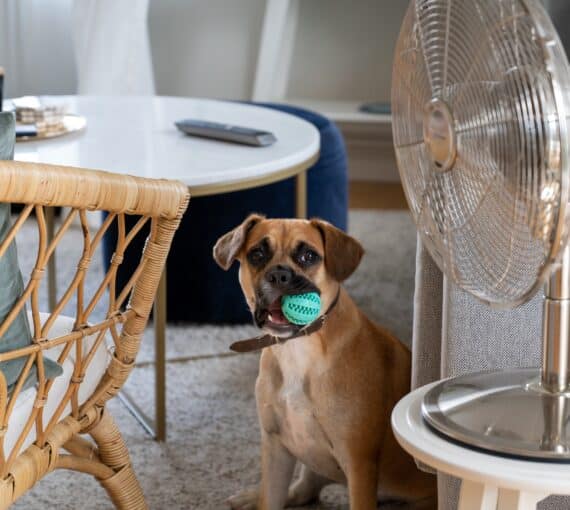
A cool indoor space will help you and the people you care about stay safe and comfortable during hot summer months. (Photo: Ketut Subiyanto via Unsplash)
Summer’s higher temperatures can warm indoor spaces significantly. This can be unsafe for some, uncomfortable for many and lead to higher energy bills for everyone. Stay cool indoors with nine simple tips and tricks that will save you money on energy bills and keep you comfortable!
Global heating and changing weather patterns has led to increasingly hotter summers in Canada and worldwide. This has created the conditions for longer wildfire seasons. Combined with increasing pollution from society’s reliance on fossil fuels and other hazardous substances, we’re facing longer, more frequent periods of dangerous air quality that can keep individuals indoors during the summer more than before. More people at home can lead to higher energy bills and consumption. But it doesn’t have to!
Nine ways to keep cool

1. Cool the people, not the space
It’s much more efficient to keep people cool instead of trying to cool an entire indoor space.
- Limit your physical activity during the hottest parts of the day, noon to 3 p.m.
- Dress in loose-fitting, breathable, light-coloured clothing.
- Use water (but be mindful to conserve during drought) and take quick cold showers, go swimming at a local pool or natural water body, or place a damp cloth/ice pack on your neck, pulse points or under your arms. Splash water on your face and exposed limbs — evaporation helps cool humans (it’s why you sweat).
- Stay hydrated. Avoid alcohol. It’s diuretic and can dehydrate you.
- Try cooling down with a cold drink and a personal fan.
- Find a shady spot in a park or forest and spend some time outside.
Need inspiration on how to connect with nature during hot months?

2. Keep air flowing
If you don’t have an A/C, keeping air circulating can remove heat from your space. Moving air also creates a wind chill effect that cools your body.
To suck hot air out, place electric fans near windowsills facing outward. Or create a cross breeze by strategically placing one fan to blow cool air onto you while the window fan pulls hot air away. Make sure your ceiling fans are turning counterclockwise so they pull hot air toward the ceiling.

3. Close blinds and curtains
Direct sunlight will brighten your space, but it can also heat it significantly and (if you have one) make your A/C unit work much harder.
Try closing your blinds or adjusting their angle throughout the day to reduce solar heat gain. If your windows face east, close them before you go to bed. If they face south, close them during the day, and if they face west, close them in the late afternoon and early evening.

4. Give your oven a break
Ovens generate a lot of heat, so try to prepare foods that don’t require as much cooking, such as salads and sandwiches. If you must bake or roast, try making smaller portions that will cook quickly in a toaster oven. Start a food sharing club and take turns cooking with others so only one home gets heated. And why not eat outside? Find a shady park and have a picnic.

5. Use fewer large appliances during the day
Ovens aren’t the only appliances that heat up your home. Set your dishwasher and clothes dryer to run overnight — or better yet, air dry your laundry. Not only will you take advantage of off-peak energy use times, you’ll minimize the heating effects of these appliances.

6. Ease off the air conditioner
Consider a programmable thermostat to help you manage your energy use so you’re not cooling your home when no one’s there. For every two to three degrees warmer you set your A/C, you can save up to 10 per cent on your monthly energy bill. If you don’t have an A/C and want some relief, visit a cool place like a community centre or library.

6. Change your air conditioner filters
Dusty and dirty filters restrict airflow, which makes your A/C work harder. Make sure you replace disposable or wash reusable filters at least every three months to ensure your system runs smoothly and efficiently and provides cleaner air for you and your family.

8. Cultivate an indoor green space
Although their impact may be modest compared to other cooling strategies, indoor plants can contribute to a cool and green indoor oasis.
Plants release moisture through a process called “transpiration.” Like how sweating cools human bodies, moisture evaporates from leaves and creates a cooling effect. A large collection of plants in a small room can collectively contribute to a slightly cooler and more comfortable environment. The more plants, the more shade and light diffusion so you’ll help reduce direct sunlight entering a room and prevent excessive heat buildup.

9. Switch to a heat pump
Don’t be fooled by the name. Heat pumps also work to cool homes and buildings.
The same way heat pumps heat outdoor air and transfer it indoors, they also transfer warm indoor air to the outside. Installing a heat pump will save you money, reduce indoor and outdoor air pollution and contribute to curtailing climate change.
To make heat pumps more accessible and affordable for more people, concerted efforts are needed from manufacturers and government incentives and subsidies programs. (See if your province offers energy efficiency programs, rebates or incentives below!)
HEAT PUMPS SAVE MONEY, REDUCE POLLUTION AND HELP THE CLIMATE
Want to make your space even more energy-efficient?
Start by getting an energy audit. You can find energy advisers in your city or town by simply entering your postal code.
Avail yourself of the many resources, rebates and incentives available to help make your space energy-efficient. Here are some opportunities in your province or territory.
-
The Residential No-Charge Energy Savings Program offers free installation of energy-efficient products and a basic energy audit for single family homes, apartments and condominiums.
-
EfficiencyBC is an online hub for homeowners and businesses to access information, incentives and support to help reduce energy use and greenhouse gas emissions in new and existing homes and buildings. Incentives are administered by BC Hydro, FortisBC and CleanBC.
-
Efficiency Manitoba is a Crown corporation committed to achieving annual energy savings targets by offering cost-effective programs and services.
-
Save Energy NB provides information on rebates, and how to apply for the Total Home or Low-Income Energy Savings and Renter Energy Kit Saving programs. Their Enhanced Energy Savings Program helps more homeowners manage energy use and costs.
-
Visit TakeCHARGE to get money back and enjoy lower electricity costs with tips and rebates on insulation, thermostats and lightbulbs, and receive financing for energy-efficient renovations.
-
The Arctic Energy Alliance provides rebates to people who purchase new, more energy-efficient models of products they use every day.
-
Visit Efficiency Nova Scotia for home energy efficiency upgrade recommendations and advice (free for income-qualified homeowners) and rebates on many energy-efficient products, such as heat pumps, hot water heaters and more.
-
The Home Renovation Program helps homeowners who wish to carry out major repairs, renovations and additions. This includes financial assistance to improve your home’s energy efficiency.
-
The Energy Affordability Program provides support to income-eligible electricity consumers by helping them lower their monthly electricity costs and increase their home comfort with energy-saving products, upgrades and home energy needs assessments.
-
EfficiencyPEI provides rebates on installation of Energy Star–certified heating equipment, including heat pumps, water-saving devices, biomass heating devices and other energy-saving products.
-
Hydro Quebec’s LogisVert Efficient Homes Program provides financial assistance for residential customers that promotes energy-efficiency measures.
-
SaskPower’s Energy Assistance Program energy advisors will come to your home and provide free energy-efficient items, such as a smart thermostat, Energy Star LED light bulbs, smart power strip, high-efficiency showerheads and aerators.
-
Whether you’re a renter or homeowner, the Good Energy Quick Start Home Energy kit will help you reduce energy use and improve comfort in your home. The Good Energy Program also offers rebates on energy-efficient appliances, windows and insulation.



